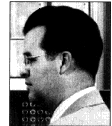Harry Douglas Huskey
Born 1916, Bryson City, N. C.; multifaceted computer designer responsible for the NBS SWAC and the Bendix G-15.

Education: BS, mathematics and physics, University of Idaho, 1937; MA, mathematics, Ohio University, 1941; PhD, mathematics, Ohio State University, 1943.
Professional Experience: teaching assistant, mathematics, Ohio University, 1938-1939; Ohio State University: teaching assistant, 1939-1942, instructor, 1942-1943; instructor, mathematics, University of Pennsylvania, 1943-1946; National Physical Laboratory, Teddington, England, 1947; National Bureau of Standards: National Applied Mathematical Laboratory (NAML), Washington, D.C., 1948, Institute for Numerical Analysis (INA), Los Angeles, Calif., 1948-1953; on leave, Wayne State University, 1952-1953; University of California, Berkeley, 1953-1967; on leave, MIT and University of California, Santa Cruz, 1966-1967; University of California, Santa Cruz: professor, 1967-1986, professor emeritus, 1986-present.
Honors and Awards: IEEE Computer Society Pioneer Award, 1980.
Huskey was an instructor at the University of Pennsylvania during the later stages of the development of ENIAC, where he wrote a technical manual for the ENIAC and worked on the early logical designs for the EDVAC. Following the departure of Eckert and Mauchly from the university in 1946, Huskey accepted a visiting position with the National Physical Laboratory in England contemporaneously with Alan M. Turing, who was working on his design of the ACE (Automatic Computing Engine). Based on his US experience, Huskey created the basic design of the Pilot ACE, which was the prototype of Turing's concept. After returning to the National Bureau of Standards in the US where he helped start the Standards Eastern Automatic Computer (SEAC) project in Washington, D.C., he moved on to the Institute for Numerical Analysis, Los Angeles, Calif., where he built the Standards Western Automatic Computer (SWAC). While on leave from INA at Wayne State University in 1952-1953, Huskey designed the Bendix G15 drum computer and commenced a long-term association with the company As a faculty member at the University of California, first at Berkeley and then at Santa Cruz, Huskey served as a consultant to many organizations and countries in computer education and the establishment of computing centers. The G-15, which the Bendix Corporation gave to Huskey, and which was used by him for many years as his personal computer, was presented to the Smithsonian Institution for inclusion in the Information Age exhibit in the National Museum of American History in 1990.
See also the biography of Velma Huskey.
QUOTATION
"In all my relations with Turing, I found him helpful. I think Turing was reluctant to see effort diverted from the "big" ACE, but he did not "boycott" the development of the ACE Test Assembly, nor did I feel that he resented my part in its beginnings."
BIBLIOGRAPHY
Biographical
Campbell-Kelly, Martin, "Programming the Pilot ACE: Early Programming Activity at the National Physical Laboratory," Ann. Hist. Comp., Vol. 3, No. 1, 1981, pp. 133-162.
Huskey, Harry D., "The SWAC The National Bureau of Standards Western Automatic Computer," in Metropolis, N., J. Howlett, and Gian-Carlo Rota, A History of Computing in the Twentieth Century, Academic Press, New York, 1980. pp. 419-431.
Huskey, Harry D., "From ACE to the G-15," Ann. Hist. Comp., Vol. 6, No. 4, 1984, pp. 350ff.
Huskey, Harry D., "The National Bureau of Standards Western Automatic Computer (SWAC), " Ann. Hist. Comp., Vol. 2, No. 2, 199 1, pp. 111-12 1.
Huskey, Harry D., "Memoirs," Ann. Hist. Comp., Vol. 13, No. 3, 1991, pp. 290-305.
Significant Publications
Huskey, Harry D., "Characteristics of the Institute for Numerical Analysis Computer," Math. Tables and Other Aids to Computation, Vol. 4, No. 30, Apr. 1950, pp. 103-108.
Huskey, Harry D., and Velma Huskey, "Lady Lovelace and Charles Babbage," Ann. Hist. Comp., Vol. 2, No. 4, 1980, pp. 299-329.
UPDATES
Harry Huskey died on April 9, 2017 in Santa Cruz. (THVV, 2017)
New content Copyright © 2013-2023 by the IEEE Computer Society and the Institute of Electrical and Electronics Engineers Inc.
All rights reserved. This material may not be reproduced or redistributed without the express written permission of the copyright holder.
